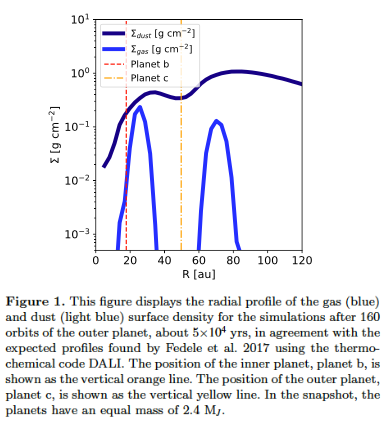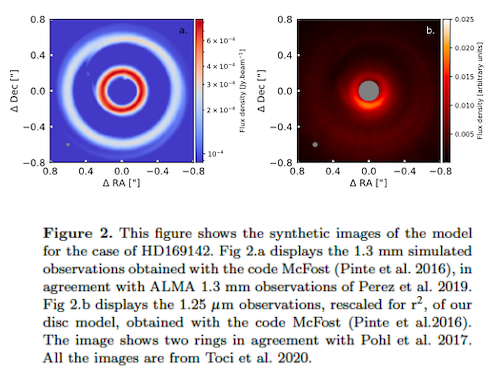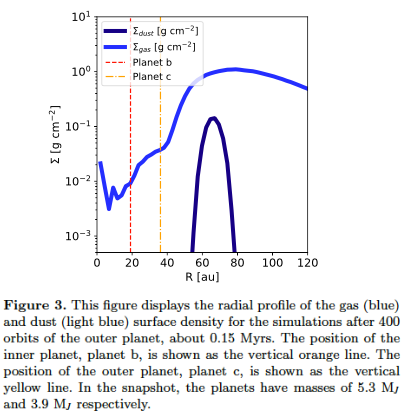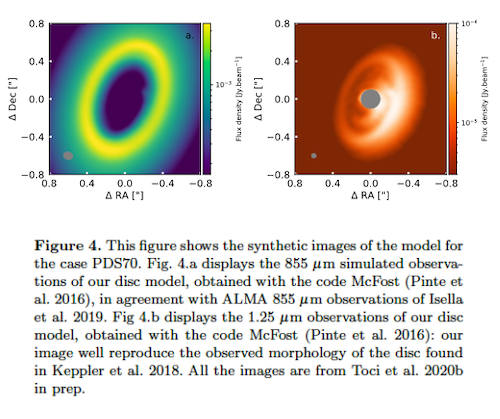Dynamics of giant planets in protoplanetary discs
- 1INAF OA Brera, Milano, Italy (claudia.toci@inaf.it)
- 2Dipartimento di Fisica, Università degli Studi di Milano, Milano, Italy
- 3INAF OA Arcetri, Firenze, Italy
- 4ESO, Munchen, Germany
- 5School of Physics and Astronomy, Monash University, Melbourne, Australia
New instruments such as the ALMA interferometer and SPHERE on VLT allowed to obtain a large number of high-resolution images of protoplanetary discs. In these images, substructures such as gaps and rings can be clearly resolved and appear to be very common (see eg. Andrews et al. 2018).
A natural explanation for the origin of such structures is the dynamical interaction of the gas and dust in the disc with one or more planets embedded in the parental disc (e.g. Lin & Papaloizou 1979, Dipierro et al. 2015, Rosotti et al. 2017, ..). Detections of planets embedded in disks are rare (e.g. Quanz et al. 2013, Keppler et al. 2018) and are mostly related to giant planets at wide orbits. However, the observed structures can be due to the interaction between the disc and low-mass planets.
Planet-disc interaction can be studied with a synergy between observational results, current theoretical model and numerical simulations. In particular, theoretical models can find “signatures” to spot the presence of planets in discs, such as dusty or gaseous features due to the presence of circumplanetary discs or accretion streams (Bae et al. 2019, Toci et al. 2020) to be compared with real observations (Isella et al. 2019). I will present an analysis of several 3D SPH numerical simulations devised to analyze planet-disc interaction in presence of two giant planets.
I will then compare my results with two observed systems: (1) HD169142 (Fedele et al.2017, Perez et al. 2019), a well studied source with two prominent rings in dust and gas; (2) PDS 70, the first source where protoplanets have been directly observed (Keppler et al. 2018). We initialise the system containing two giant planets in the disc (hereafter planet b and planet c respectively), studying the initial conditions that lead to the formation of a cavity in the gas distribution and rings in the dust. I will present the results about the dynamics of these discs (gap width, ring size and shape, cavity shape) and the properties of the planets (Toci et al., ApJL 2020, Toci et al. 2020, in prep.). My results show that the presence of two giant planets in a 5:1 resonance can be responsible of a long-lived dust ring between them, while at the same time creating a large gas cavity. However, the dust ring is absent when the giant planets end up in a closer resonance (3:1 or 2:1). I will also show how important it is to consider the migration and the accretion of planets for modelling observational results.
Indeed, the interaction between the planets and the disc can give signatures both in the dust and gas components, leading to detectable features. In particular, our results suggest that the spur in the observed 1.3 mm continuum images of Perez et al. 2019 can be due to the interaction between the inner giant and the inner dust ring (see Fig. 1 and Fig. 2). If so, the spur should move according to the orbital motion of the planet. This theoretical prediction will be testable in a few years with new ALMA observations. Similarly, in the case of PDS70, the structures observed in Keppler et al. 2018 and Isella et al. 2019 can be explained with an accretion stream from the disc to the planet and the presence of a dusty circumplanetary disc (see Fig. 3 and Fig. 4).




How to cite: Toci, C., Lodato, G., Fedele, D., Testi, L., Pinte, C., Christiaens, V., and Price, D. J.: Dynamics of giant planets in protoplanetary discs, Europlanet Science Congress 2020, online, 21 September–9 Oct 2020, EPSC2020-438, https://doi.org/10.5194/epsc2020-438, 2020

